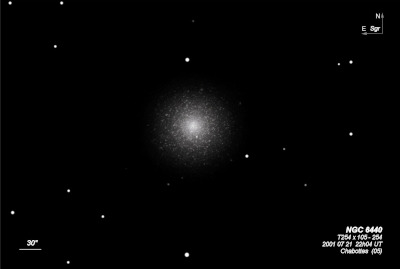
William Herschel discovered NGC 6440 = H I-150 = h1985 on 28 May 1786 (sweep 569) and recorded "cB, R, vgmbM, about 1 1/2' diameter."
Based on early Crossley plates of the region, Heber Curtis wrote a note in 1918PASP...30..161C titled "A Spiral Nebula in the Milky Way." He stated "The nebula NGC 6440 appears to form practically the only known exception to this rule [that spiral nebulae are never found in the Milky Way itself]. Although this object is some distance from the center of all available Crossley plates of this region, rendering its details somewhat indistinct, there seems to be no doubt that it is a rather bright, nearly round, very compact, spiral nebula 1.5' in diameter. Its unusual interest lies in the fact that it is less than 2° from the galactic plane." Before this erroneous note was published a footnote was added stating another plate was taken and "the probabilities are that it is a compact star-cluster showing evidences of spiral formation." Based on photographs taken at the Helwan observatory in 1919-20, the description also reads "some indication of the stars being in spiral formation".
300/350mm - 13.1" (6/29/84): moderately bright, small, broadly concentrated to a brighter core, no resolution. Forms a striking pair with planetary NGC 6445 20' NNE. Brightest member stars are only V = 17.
400/500mm - 17.5" (7/14/99): this globular forms an unusual pair with planetary NGC 6445 just 21' NNE and is situated within a string of four mag 11-12 stars oriented NW-SE. It appears fairly faint, round, at least 2' diameter. At 280x the diffuse halo increases to a moderately bright, round core. Although the globular appears granular, there was no resolution in good seeing except for a very faint star that was intermittently visible off the north edge of the core.
600/800mm - 24" (8/14/15): at 375x; bright, relatively small globular, sharply concentrated with a very bright core and a much fainter, well-defined circular halo, roughly 2' across. The core was mottled and very granular but unresolved. NGC 6440 is collinear with an 11' string of four mag 11-12 stars extending from NW to SE, barely fitting in the field, with the closest star 1.7' NNW of center. At 500x, a few extremely faint stars were resolved in the halo. The bright core contains a handful of resolved stars (mag 16.5 or fainter) that popped in and out of view over the extremely granular background.
NGC 6440 is a highly obscured, metal-rich globular at a low galactic latitude, so resolution is quite difficult.
Notes by Steve Gottlieb